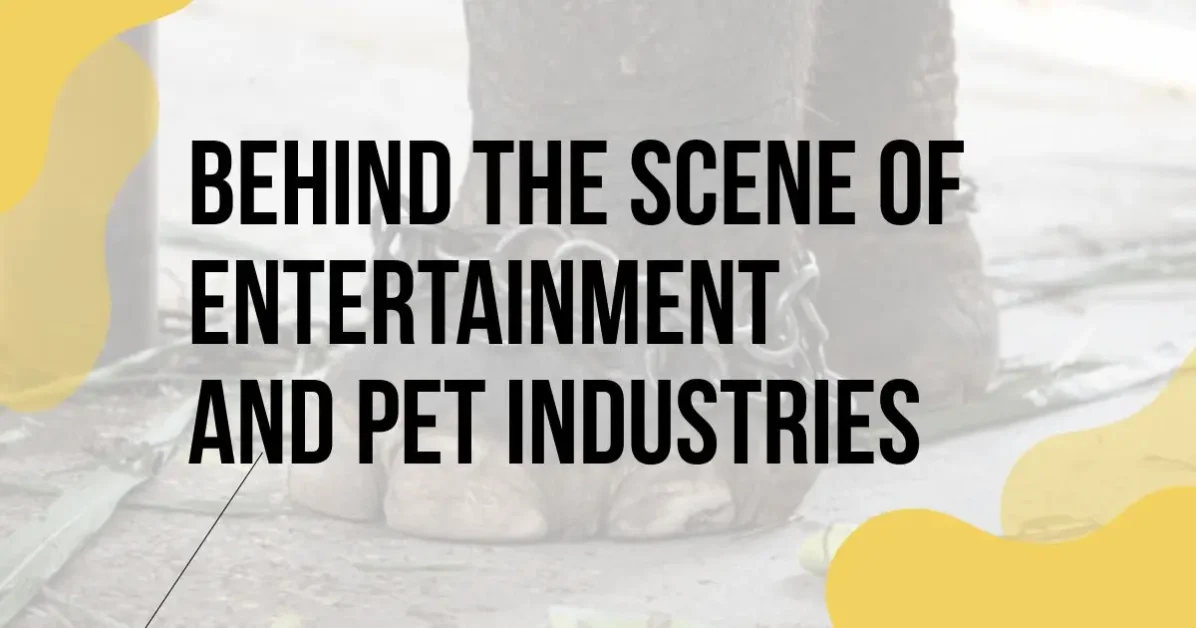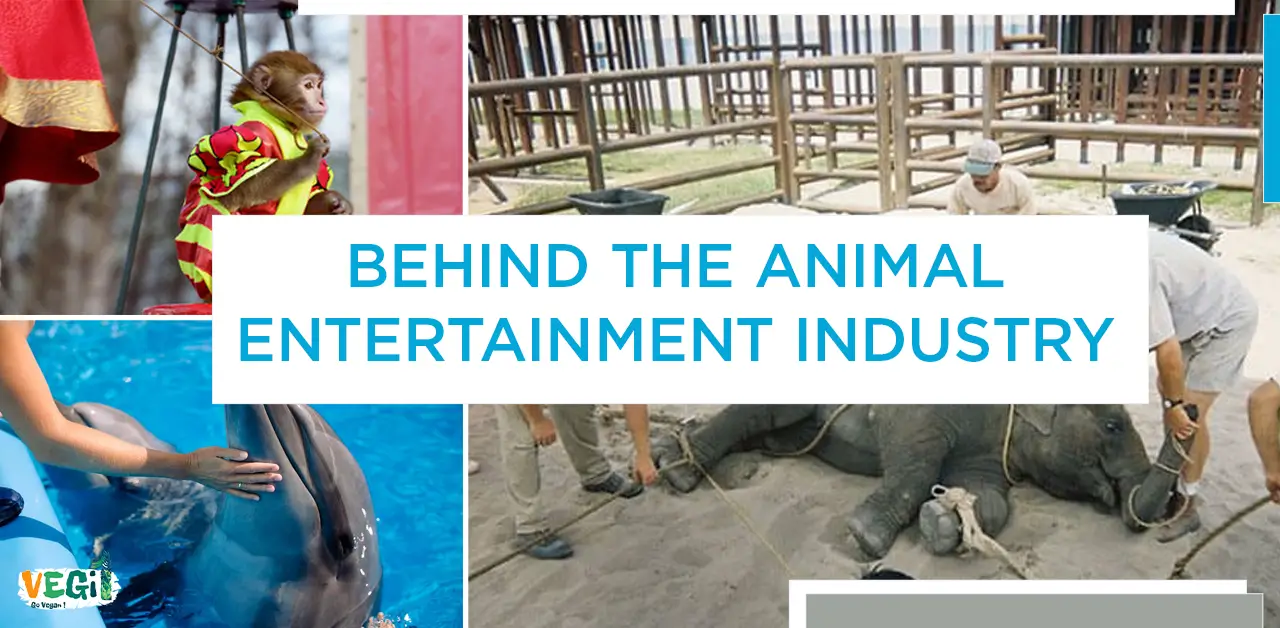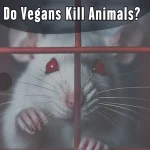What Really Goes On With Animals in Entertainment and the Pet Industry

I’d like to start this paragraph with this thought-provoking comparison. Imagine for a second that you, as a human being, had no free will to choose your own fate and were confined to live in filthy, cramped, and tiny areas so that you could amuse others and be a means of profit for them. Feel the same thing for animals, who are the subjects of entertainment for humans in various industries like marine parks, aquariums, zoos, redoes, elephant rides, and many more, which we’ll dive into later in the article.
Another serious matter that has been occurring for a long time without anyone questioning the reason or changing their views about it is the way animals are perceived. Let’s consider this example to better grasp the situation: Have you or your child ever felt the urge to buy a pet like a dog or cat to accompany you simply for the sake of entertainment? Have you felt bored and lonely and then thought about buying a pet to fill up your loneliness and keep you company?
This is just the tip of the iceberg of the animal entertainment industry. Countless other fields are abusing animals right in front of your eyes, yet go unnoticed because you’re unaware of the behind-the-scene animal entertainment
or other forms and areas that use painful and dirty tricks on animals to get them prepared for shows or use inhuman methods to raise and train animals.
So, before you doing anything else, stick with us for the rest of this article as we intend to open your eyes to the pet and entertainment industry, which will undoubtedly discourage you from heading to pet shops, animal competitions or animal displays and so on.
How can we stop animal cruelty in the world?
In this article you will read:
How Society and People Have Seen Animal Entertainment
When it comes to the view of animals, they have often been seen as mere tools and objects to entertain, amuse, and rake money in for heartless humans. The reason is quite clear: over time, people developed a mindset to place themselves above other creatures, or in other words, a hierarchy that places humans at the top of the pyramid. However, these false beliefs led to the suffering and endless pain of animals by being tortured and abused. Yet these ideas weren’t just limited to animals or other creatures. In old times, people would treat humans horribly based on their race, skin color, and other silly reasons; those treatments weren’t any different from what’s been happening to animals nowadays, like using them as salves, keeping them chained or in cages, trading them, forcing them to perform silly tricks in front of people with higher status, and many more unbelievable actions. They’re all crystal clear if you look into history. So, the bottom line is that there was a clear need for change for those humans in the past as it is now for animals since they are complex beings and deserve fair and ethical treatment.
Now, if we take everything into account, should we really use animals for entertainment and keep them as a hobby? Should we really dominate animals, separating them from their families and natural habitats? All of these cause great physical and emotional pain, just like we experience.
Overall date about the use of animals in the pet industry
Animals don’t want to perform in shows, be sold and traded to raise profit or be someone else’s hobby. There is a vicious cycle going on every time in these massive enterprises, which consists of breeding, buying, and selling animals, then discarding them for any reason that might prove they are useless to the profiteers. This all results in a huge number of animals being tormented in all kinds of industries. Let me give a brief statistic of animals that are the subjects of entertainment and pet industries and shed light on the overall scale of animal usage.
Did you know that every year, around 10 million animals die from all forms of abuse, neglect, and cruelty in the US.
Can you believe it’s estimated that every minute, one poor animal is exposed to some form of abuse somewhere in the US?
Take circuses, for example. Those animals spend 11 months of a year in transit, chained in cages and locked in gnarly cells. Even when they are supposed to be free, they are either performing or getting tortured to be trained in shows. Even worse than that is the fact that around 75 % of exotic animals like turtles, snakes, lizards, and tortoises taken as pets die in captivity within the first year.
As I mentioned before all data was gathered from reliable and solid sources, which all are linked up on ‘usatoday.com‘.

Behind the Scenes of the Animal Industry
Humans are fascinated by animals, and watching their majesty and unique features is surely thrilling. But when it comes to using animals for entertainment purposes, there comes extreme cruelty. The shimmering and shining curtain of animal entertainment is nothing but an illusion, all created by cruel humans trying to deceive you into attending their shows and other forms of entertainment on display. However, a harsh and heart-wrenching reality lurks behind this industry. Poor animals are being taken advantage of, suffering, and dying for the pleasure of audiences. These animals have no say in their life choices; they are deprived of anything that satisfies their natural needs and frequently go through extreme physical and emotional wounds that sometimes kill them on the job.
A human going through such conditions wouldn’t last long! Besides the depression and humiliation one experiences.
Considering that a human can speak up about their rights. But what about animals?
There are almost certain entertainment animals that perform and appear in public to amuse people. These silent victims are forced to act in different venues like circuses, carnivals, animal exhibits, wildlife theme parks, aquariums, zoos, museums, fairs, motion pictures, and television programs. All of them have the same thing: viewing animals as mere toys for human entertainment.
Somehow, people actually pay money to watch events featuring all kinds of animals. In circuses, a certain group of animals is prominently selected and abused under the threat of punishment; such poor animals include zebras, tigers, lemurs, elephants, gorillas, lions, bears, apes, giraffes, birds like parrots, doves, peacocks, and cockatoos.
You’ve already seen and heard about the ongoing activities in circuses, like forcing lions to jump through fiery rings or pushing elephants and gorillas to perform funny tricks. But, what painful training leads to this kind of performance is something we’re going to cover further below.
A list of Animals in the Spotlight that are Used for Entertainment
Let’s take a closer look at the statistics and data about the primary animals subjected to unimaginable abuse and cruelty for human entertainment. Their lives are far from the natural and enjoyable displays we happily look at on screens.
-
Dogs
The use of dogs in the entertainment industry is a long and heart-breaking list. A huge number of dogs are put on display in circuses, often forced to be interesting and bring thrills to the humans. Then, we have agility competitions and dog racing. In some cases, film and television programs don’t miss the chance to misuse different breeds of dogs with unique abilities and roles of their own.
-
Cats
Unfortunately, a great number of industries like circuses and carnivals feature cats in their shows and competitions where they’re judged based on their abilities, attributes and breed type. Cats are also popular subjects of internet videos and memes.
-
Hamsters
Although hamsters may appear on various shows, these animals are mainly kept as pets. They might perform at small pet shows and exhibits where owners showcase their hamsters’ agility and tricks. For example, hamsters might be made to run on wheels until exhaustion, or pushing them into storing as much food as possible in their cheek pouches to get a smile on audiences faces!
-
Birds
Like dogs, profiteers exploit birds in every way possible, not giving the slightest care about ethical matters, just finding ways to make money out of poor birds.
Bird shows, bird singing displays, and bird training demonstrations force them to learn tricks through painful methods, as they are unable to keep up with our needs and surely are not supposed to.
Since parrots can mimic human speech, they are attractive to pet and entertainment industries, making them one of the most victimized birds. Birds with eye-catching plumage, like peacocks, are kept mostly in zoos and parks out of their living areas only to appeal to visitors.
-
Otters
They can be found in zoos or aquariums, where they showcase their playful behaviors. They are cute, semi-aquatic mammals who are great at swimming and dexterous use of their forepaws.
However, their charisma and appeal don’t make them suitable pets or toys to exploit by different industries.
-
Snake
Strangely, we can see snakes being kept as pets, especially species like pythons and boas. These exotic animals, as I mentioned earlier, won’t live more than a year because their living environment sees a huge shift.
Abusing these voiceless creatures doesn’t stop right there; in reptile exhibits, which are either educational or mainly entertaining, handlers hurt and misuse snakes. Then there are snake-handling demonstrations and so forth.
-
Monkeys
These animals are incredibly intelligent, with magnificent and complex societies. This makes them a suitable target for racketeers to smuggle and sell them to a large number of industries. As they can be trained to obey and comply with handlers in zoos and circuses, making them literally playing with fire.
Punishing them, depriving them of food and nutrients, isolating them, and many other cruel acts that break them and push them to the brink of death.
Not to mention their exploitation in television shows and movies.
-
Rabbits
Have you ever stumbled on a magic show that features rabbits appearing or disappearing by the magicians’ hats or boxes filled with sharp blades? Do you know how such rabbits feel or how intense and savage their methods are that make rabbits submissive?
In zoos, they are constantly drugged to be soulless, depressed, and with no sense of liveness, just to make sure they behave in those tiny, cramped cages.
There is another long story with farms and breeding operations that store rabbits in order to kill them, using their meat and skin for silly human purposes.
- Chickens
They are not typically used for entertainment purposes, unlike the animals mentioned above. Instead, their main suffering stems from agriculture and farming practices. These domesticated birds are raised for their meat and eggs.
Humans are only keeping them for lay-egging and breeding activities that don’t regard how they live. As long as they are useful, they’re abused, and after that, they are discarded or killed.
Just like that, as if they’re dolls of a 7 year old kid
All the Different Ways that Animals Get Exploited and tortured
In zoos, circuses, and other entertainment settings where animals are the main attractions of the show, trainers often rely on forbidden and unbearable methods to make these animals perform acrobatic and demanding tricks. Can you imagine using bullhooks, whips, tight collars, muzzles, electric prods, and other pathetic tools to beat animals, breaking their boons and necks, or even killing them? This is the case for countless animals dying during punishments and confinement. In fact, many circus workers get killed or snapped while training or feeding these animals.
So now we know that the pleasure and fun animals give to people in such industries all around the world is the result of harsh and violent training.
Take this, a former circus trainer ‘ Vladimir Deriabkine, ‘ has testified about witnessing a trainer kill a bear for showing disobedience and refusing to performs as he desired.
As I said, I’m going to delve into the terrible and cruel methods that trainers and owners in animal entertainment and pet industries rely on to make animals do as they wish or make them suit industry needs.
Physical abuse
-
Whipping
It’s hard to imagine what it feels like to use whips as a tool to make living beings with emotions and feelings prepare for performances or make them obedient. This kind of punishment is used for horrible criminals who’ve badly hurt people in some kind, not for poor animals who have done nothing wrong. Yet humans misuse and torture them.
-
Electric shock collars
These collars, placed around poor animals’ necks, deliver a painful and agonizing shock to them, all for the foolish purpose of compliance and changing their behavior against their own will. If they don’t behave and try to free themselves from those monsters, they face this kind of punishment.
-
Declawing
This cruel act is common in both pet and entertainment industries which involves the procedure of removing animals’ claws through painful surgeries. It can be done to prevent animals from harming trainers in circuses or scratching furniture at home.
It’s like violently removing our own nails! I can’t help myself, but picture the infection and chronic pain they experience during and after the procedure.
-
Docking tails and cropping ears
This one is another unacceptable surgery that removes an animal’s tail or ears for cosmetic or other foolish reasons, especially in dog breeds like Doberman, pinschers, boxers, and other iconic animals misused in these industries. Some false beliefs around these cruel acts are that removing a dog’s ears can make them violent as guardians and increase their speed and strength. All a bunch of lies designed to inflict unimaginable pain on them.
Confinement and isolation
No matter which kind of industry we dig in, all of them keep innocent animals in cages and enclosures for long periods of time. This includes forcing animals to live in confined spaces or endure hauling and transportation acts. Besides that, it doesn’t end right there; these animals are neglected and starved to death because nobody cares about them in these industries. So, animals are not able to express natural behaviors and live a normal life like they deserve to, and will certainly experience loneliness, boredom, and physical pain like muscle atrophy, joint pain, and stomachaches until they meet their death.
I’m sure you’ve already realized by now how close their experiences are to ours and how terrible we feel if we go through the same things over and over.
-
Neutering and spaying
To be more specific, neutering is a traumatic and painful surgery done on male animals by removing their reproductive systems like testes, and the same applies to female animals, which is called spaying (taking the ovaries and uterus of their organs).
The way people justify such actions is that they want to control pet populations and prevent unwanted litters. But these are not something that pets have chosen to do. We see these sterilization acts in both entertainment and pet industries, but mostly in pet industries.
If people want to keep pets, they must provide every essential needs for their pets and not miss a single thing. Taking over a pet is a huge responsibility and takes extreme effort. It’s like keeping and raising your own child. So, instead of performing horrible surgeries on them, we must have responsible pet ownership and let them show natural behaviors by bringing a mate for them.
-
Overbreeding and puppy mills
This is frequently done in pet industries, where animals like dogs, cats, cows, and chickens are subjected to forced breeding to produce more offspring for commercial and moneymaking purposes. How can a person be so cruel and indifferent to force something like that on sentient beings? Knowing that the whole process, before and after, is traumatic and painful for animals.
Common violent acts in this kind of torture include the use of hormones and antibiotics, as well as inhuman slaughter practices. Now we know that overbreeding is accomplished by cruel acts, which lead to overpopulation and the neglect of these animals’ very basic needs.
As for puppy mills, dogs, for example, are bred repeatedly without enough rest, which brings physical and emotional problems. Then, they are kept in overcrowded and dirty cages with no nutrition, veterinary care, or social interaction.
Imagine what all these conditions would do to a human being?
In previous paragraphs, I had a brief look into the entertainment and pet industries. But now our main focus is to shed light on the realities hidden from the public in all forms of entertainment industry.
I intend to thoroughly explore various industries that profit from animals in captivity and exploit them, from circuses and zoos to theme parks and animal competitions. In addition, I will delve into the use of animals in movies and TV. Exploiting animals takes many forms, but in this article, I don’t present information in a detached and unemotional manner and then move on. I’ve buckled down to expose the hidden truths beneath the thrill and facade of entertainment industries.
As a vegan, I’ve come to realize the urgent need to speak up for these innocent and poor creatures who nobody cares about what happens to them or what they live through in these large enterprises. Let’s be clear, we all know that when someone only thinks about money and puts everything above that, only focuses on profit by all means, whether it’s to abuse animals or humans. They abuse and misuse them until the moment they can’t breathe anymore.
However much suffering those poor animals endure, they don’t mind. All entertainment and pet industries that directly or indirectly mistreat animals are ignorant towards them. These are the very individuals who are willing to do the same horrible actions to humans for their own gain. As a matter of fact, we’re seeing human trafficking mobs and other dirty organizations using humans for joy and profit. An example of that is the legendary and infamous story of “red rooms” displayed on dark and underground websites. It’s assumed they are kidnapping and slaughtering humans for the pleasure and personal gain of some twisted people.
Attending animal entertainment shows and, therefore, putting money in their pockets is no different than supporting human slaughter practices. We both have the capacity to feel emotions and pain, with millions of nerves that transmit every single sensation to the brain.
Would you agree to go along with that? I guess not!
The Use of Animals in various industries
-
Circuses:
Now, let’s dive into the long-running issues of animals in circuses, zoos, and theme parks. At first sight, you enter circuses, and everything appears to be fun or even educational. But the reality is far from it.
I’ve already mentioned that animals are subjected to live cramped and unnatural living conditions like in beast wagons, deprived of their freedom, and forced to perform for the sake of human amusement, and the unnoticed stress they experience.
In the long history of abusing animals in circuses, horses were at first the main ones involved, but as time went on, they brought on lions, tigers, bears, chimpanzees, alligators, llamas, rhinos, and elephants into the mix.
Now we’ve reached a point that these circus animals are bred in captivity, with handlers somehow trying to domesticated them. But in case of wild animals like elephants it never happens, as it is unlike their innate values and instincts, even when they are captured from wild directly.
Down below, I’ll show a list of activities that some iconic animals are compelled to perform:
1. Elephants:
– Standing on their hind legs or balancing on a small platform.
– Performing headstands or handstands.
– Walking on a tightrope or a balance beam.
– Spinning in circles or pirouetting.
– Carrying or lifting objects, such as logs or other animals.
– Riding bicycles or tricycles.
2. Lions and Tigers:
– Jumping through hoops of fire.
– Leaping over obstacles or through rings.
– Roaring or growling on command of cruel trainers.
– Performing synchronized movements or formations with other animals.
– Climbing on pedestals or platforms.
3. Bears:
– Riding bicycles or skateboards.
– Walking on their hind legs.
– Rolling over or playing dead.
– Balancing or juggling objects.
– Riding on the back of a trainer.
– Clapping or waving their paws.
4. Monkeys:
– Riding on miniature vehicles or tricycles.
– Performing acrobatic tricks, such as somersaults or flips.
– Riding on the backs of other animals.
– Playing musical instruments or engaging in mock human activities.
– Interacting with trainers through gestures or mimicry.
– Collecting items from the audience or retrieving objects.
As you now are aware, these sentient and conscious animals are being made to do impossible tricks like the ones I brought up earlier, tolerating unimaginable pain (from lack of food to brutal methods of training) all for two purposes: Entertaining humans and generating money.
Please be aware of their living conditions and sympathize with them.
Zoos:
Zoos, similar to other entertainment industries, have this absurd claim to be educational and play a crucial role in the conservation of endangered species. But the reality is that all kinds of animals in zoos live in unnatural and confined environments. Once you walk into the zoos, you can see a variety of species like birds, mammals, reptiles, amphibians, and invertebrates. For instance, you can observe wild animals like pandas, hippos, koalas, primates, giraffes, big cats, birds, zebras, camels, and snakes.
Each of these species must live in different climates and environments with varying vegetation. But can we really confine these large groups of animals, each having to live and breed in special conditions and corners of the world, to a single cage? It’s as if bringing individuals accustomed to cold climates and forcing them to live in hot, horrible cells.
Then, in order for animals to behave, zoo workers inject sedatives in their inadequate food, so they’re constantly in lethargy state. These animals are separated from their social groups and denied the chance to have natural behaviors based on their innate instincts.
Nobody has the right to take away any creature’s life or subject it to harsh conditions for the sake of their own amusement and profit. Shockingly, the average death age for elephants in European zoos was found to be just 17 years, whereas elephants in protected areas in Africa can live up to 56 years, as reported in a study published in the journal Science.
In fact, animals in captivity, especially those in zoos, are prone to developing mental issues. This mental disorder is called zoochosis. As I mentioned several times earlier, animals are showing abnormal behaviors in confinement, like swaying, pacing, and head-bobbing, all resulting from depression, isolation, torment, frustration, and neglect. This highlights how emotionally complex animals are and how damaging entertainment industries are. These abnormal behaviors were initially seen in cold-blooded criminals in solitary confinement, which is what they deserve. However, why do animals have to go through it? What wrongs have they committed? Aren’t they valuable creatures living on earth as we do?
Now that you are aware, feeling responsible for them is just as necessary as it is for our own friends. So, the next time you think of zoos as a leisure activity and a fun place to visit with your family, don’t overlook the details about their confinement, torture, and the horrible results of these two.
Theme park:
Animal theme parks, often referred to as zoological theme park, combine elements of both an amusement park and a zoo, aiming to provide entertainment, amusement, and moneymaking purposes, according to Wikipedia. Animal theme parks basically lump classic theme park attractions like amusement rides with zoo features such as live animals confined within cages for display. Nearly every day, such animals become part of amusement rides and other attractions at theme parks.
Equestrian Clubs:
Equestrian clubs mostly revolve around horses and offer horse shows, racing events, and riding lessons. One of the main activities in equestrian clubs is providing riding lessons, which is surprisingly considered a sport. Here is the problem: the treatment of experienced instructors who give lessons about horseback riding techniques.
How they treat these poor horses is our main concern. As you know, horses must be compelled to be placed in riding lessons as it’s unlike their nature to live in such conditions or to be used solely as sporting tools. Instructors often use whips and tight lariats to convey extreme pain to horses. Is this what you call a sport? Hurting an animal with complex emotions, just have some fun?
Additionally, equestrian clubs organize other events like shows and competitions where professional members will showcase their riding skills and compete against each other. For example, they engage in dressage (the execution of precise movements by a trained horse in response to barely perceptible signals from its rider, defined by Merriam-Webster.com), show jumping, barrel racing, and trail riding. Each one of them puts innocents under heavy pressure, causing them pain and suffering. These horses have to comply and endure heavy pain like slaves, and if they don’t, punishment is expecting them.
Take a look at data below to get a real sense of how terrible these clubs are:
– The Coalition for the Protection of Racehorses in Australia reported that more than 1,000 racehorses are killed in Australia each year, either on the track or as a result of injuries sustained during training or racing.
– The British Horse Racing Authority reported that approximately 200 horses die each year as a direct result of racing-related injuries in the UK.
SeaWorld, Aquariums & Dolphinariums
SeaWorld and other establishments, like dolphinariums and aquariums, have been doing the same terrible actions to animals as circuses do by providing the same insufficient living conditions to animals and other forms of torture, as already discussed. Basically, what happens in these industries is confining dolphins, whales, and other marine creatures in small tanks, stripping them of the vast oceans they are meant to inhabit and thrive in. The damaging effects of taking them from the oceans and seas directly destroy ecosystems, the very system that supports our life on Earth. These highly smart sea animals who are captive-bred still sense the torture and abuse and suffer non-stop.
The same goes for aquariums and equestrian clubs that rank entertainment and profit above all else. It’s about time to question such practices and do something about it like we would for our friends.
-
SeaWorld:
SeaWorld is perhaps the most well-known type of dolphinarium. The park has become famous for the ill-treatment of marine animals, especially killer whales. Orcas in captivity are separated from their families, which almost kills their mothers emotionally from this separation. Then, like other dirty entertainment industries, the same pattern applies, living in small tanks and being forced to perform tricks for audiences. Sometimes, it’s claimed by such industries that their main intention is only to educate schools and children to visit and learn from these magnificent creatures. But there are alarming facts that tell the opposite. Here is some very worrying and grim data about SeaWorld.
According to the National Oceanic and Atmospheric Administration (NOAA), the average lifespan of an imprisoned killer whale is way shorter than that of wild killer whales.
Male orcas in captivity have an average lifespan of 17 years, while females live around 29 years. In the wild, however, they can live up to 60-70 years.
There is a clear need to change public attitude in favor of animals, and make a huge drop in people’ attendance in SeaWorld.
-
Aquariums & Dolphinariums:
Aquariums, similar to dolphinariums, keep marine animals in captivity for public display and amusement. Common animals in aquariums include diverse species of fish, jellyfish, octopuses, seahorses, sharks, rays, and invertebrates like sea stars and anemones. Some aquariums also feature marine mammals such as dolphins, seals, sea lions, and even beluga whales or orcas, just like in SeaWorld.
The only difference dolphinariums have with aquariums is that the first one mainly focuses on dolphins, abusing their cleverness by forcing them to paint, dance, do aerobatics in swimming and so on. I wonder what training they have to go through to master such skills?
Founders and profiteers of aquariums claim that their goal is to educate people about marine life and its importance to the environment. However, given the many alternatives we now have, like holographic aquariums, there is no need for actual animals to be kept there. So, you can clearly see money is the only motivator for these people.
Many aquariums feature large tanks that can’t house the natural swimming and foraging behaviors of marine animals; this leads to a non-stop vicious cycle of physical and psychological suffering, neglect, and pain. An example of this is the study published in the journal Animal Cognition, which found that captive dolphins in aquariums devote loads of time to engaging in abnormal behaviors. These behaviors include swimming in circles, floating motionlessly, and self-mutilation, all suggesting stress and frustration. The disorder I talked about earlier (zoochosis) in the zoos section is also seen in marine animals as well.
Animal Competitions: Horses, redoes, Dogs & Cats
Animal competitions lie between horse racing, rodeos, and dog and cat shows. They are deep-rooted in our society. People think of them as interesting venues for cheering, having fun, and gatherings, but the dark side of these events is usually kept under wraps. Animals are pushed to their physical limits and subjected to heavy torture if they disobey and then have to endure cruel training practices and be exposed to brutal methods like doping or physical alterations for aesthetic purposes. The main concern of such brutal and cold-blooded individuals is solely to chase after prizes and cash, ignoring the well-being of these fellow beings. We must question the ethics behind these competitions and consider alternative forms of entertainment that do not exploit animals.
-
Horses
Horse competitions exploit animals in the same way as equestrian clubs do. To put it differently, we can say almost all sorts of horse competition events are held in equestrian clubs. For a reminder of how terribly they are treated and the training they ought to cope with, scroll above and read more about it in the equestrian club’s section.
-
Redoes
Additionally, rodeos, in western cultures are extremely popular with many spectators, where participants have to exhibit their skills in handling livestock and horsemanship. Basically, this kind of sport refers to events that feature activities like bull riding, barrel racing, calf roping, steer wrestling, and more.
If you’re not familiar with these terms, let me explain.
Barrel racing: The rider forces a horse to run a cloverleaf pattern around barrels in the fastest time. Consider the process they go through before and after participating in this race, terrible living conditions, harsh training methods, punishment, and injuries. This is not what they’ve signed for, as they ought to live in the wild, have families, play around, and do many other activities that we, as humans, do regularly and instinctively. If any creature, both animals and humans, is denied to engage in natural behaviors, it would experience depression and even suicidal thoughts. Because these animals are not insentient and breathless toys, they do have feelings and perceptions the way we do.
Steer wrestling: Also called bulldogging, is a rodeo event in which a horse-mounted rider chases a steer, drops from the horse to the steer, then wrestles the steer to the ground by grabbing its horns and pulling it off-balance so that it falls to the ground. After that, they need to lasso and restrain them as quickly as possible, defined by Wikipedia’s definition)
Bull Riding: Bull riding is one of the most well-known brutal events in rodeo. What generally happens is that competitors attempt hard to stay on bucking bull for a set of time to see who can handle and control them better.
Innocent bulls are confused and overwhelmed by these events, barely living a life and only existing in awful conditions with suppressed complex needs and emotions. In the field, they are brought forcefully to amuse people by wrestling, getting injuries, and driven mad for nothing but silly purposes that embitter and torture them. The only ones profiting from these venues are violent and heartless individuals that I’m sure none of us want to put money in their pockets or be the reason for the suffering of our fellow beings.
Calf Roping: Also known as tie-down roping, it is one of the cruelest forms of entertainment at a rodeo. In this activity, three-month-old calves are chased at high speed, usually with horses. Specifically, ropes are thrown around their neck, then dragged to a sudden stop with the very rope choking their neck, and at the end, they are thrown to the ground. This is a horrific experience that causes stress, fear, pain, and sometimes death for these poor calves, according to SAFE’s website.
These animals aren’t toys or some kind of emotionless robots. We, in fact, share a genetic and evolutionary history with animals, making us closer and similar in many ways such as basic needs and emotions.
The underlying purpose of holding these contests is to generate huge profits for uncaring individuals and distract spectators by cheering on their favorite competitors, covering the truth from their eyes, and torturing animals.
-
Dogs & Cats
Dog and cat shows typically focus on breeding, showcasing the skills, agility, obedience, and other talents of these adorable and domesticated animals. Some of these skills are forcibly taught to them, or they are naturally possessed by them. In either case, they are pushed beyond their limits, and we’ve got loads of savage and brutal forms of competition.
In conformation shows, which are held for both dogs and cats, judges weigh up dogs and cats in many ways based on their particular breed standards. For example, they assess physical attributes such as structure, movement, coat quality, and overall appearance, such as eye color, temperament, and other factors.
In particular, The British Veterinary Association has expressed concerns about the welfare of certain dog breeds bred for exaggerated features, such as brachycephalic (short-nosed) breeds. These dogs often suffer from breathing difficulties, eye problems, and other health issues.
Agility & Obedience Trials: Dogs, in particular, have a great ability to learn and be flexible due to their intelligence. Now, some people abuse this talent of dogs by running obedience trials that test a dog’s ability to follow commands and display good behavior. These trials include Getting injured, having to comply even if you don’t want to, hours of training, and using conditioning methods to manipulate the dogs into doing whatever the trainer wants them to do. This treatment leaves them hurt and frustrated.
In agility trials, dogs must navigate a series of obstacles like high jumps, tiny tunnels, weave poles, and many more in a limited period of time. Dogs have to try to their hardest, all resulting from conditioning practices, as they expect some kind of treat after complying.
Performance events: Many competitions are included in these events, where animals are used carelessly, ignoring their innate rights and using them like toys. Such competitions include fly ball, dock diving, freestyle dancing, and more. Afterward, dogs are awarded based on their success in completing tasks and better responses to trainers’ commands.
The Use of Animals in Movies & TV:
Movies and television often display cute and clever animals in interesting and heartwarming roles, as if they willingly applied to do this, and are getting paid for!
But no, they were brought in by force, with little consideration of their needs.
They are cast as actors in movies and advertisements because of the attention they draw and their noticeable appearance, which leads to the generation of more income for merciless individuals.
At the scene, they are repeatedly forced to do rehearsals to ensure they act well in front of cameras. You can’t imagine what they go through before, during, and after the training and filming. The places they are kept, what they eat, what violent methods are used to get their compliance, and many other serious conditions. In these industries, animals do activities against their will, which not only provides no benefits to them but also leads to getting tortured. No matter what they do, they are destined to live a horrible life even if they comply with the brutal practices. I’m sure you can relate and grasp the situation by feeling a bit of their suffering.
For example, consider the Dr. Dolittle series, which forced all kinds of animals to perform. They certainly didn’t sign up for these roles and won’t get paid for it!
The only thing is subjecting them to tortures to act based on the director’s wills. The unfortunate bears, dogs, monkeys, chimpanzees, dolphins, whales, equines, cats, crows and farmed animals don’t deserve to live like this and be the victims of human entertainment. They deserve a happy life based on their inner instincts, as they are extremely similar to us when to comes to how they comprehend and process emotions.
This is what’s been happening in reality, an animal supplier for shows on the USA Network, Disney+, AMC, and Netflix was keeping more than a dozen dogs kept in kennels stacked on top of one another in a garage, animals crammed into closets, and an alligator held in a small, filthy outdoor pit reported Katherine Sullivan for PETA in 2020″ (written by sentientmedia.org).
So, please stop supporting the use of animals in movies and programs.
We should consider alternatives to add depth and beauty to our TV shows, such as CGIs (computer-generated imagery) and special effects, to create realistic animals without their actual involvement.
Let’s get on with the fundamental principle and fact that animals are our buddies and fellow beings, not objects for our entertainment or profit. Whether they are performing in circuses, theme parks, or sharing our homes as pets, animals deserve respect, love, and consideration.
The unspeakable actions done to animals behind closed doors of the pet industry are truly shocking. From the way they are bred to the places they are kept, poor nutrition, and ill-treatment. The problem mainly originated from how worthless animals were perceived in the past, which has continued until now. But those days are gone, as we are here to open your eyes to the reality.
By now, you should know that animals have feelings and emotions that set them apart from inanimate objects like stones, placing them in the same category we fall in.
This makes me wonder what would happen to humans if they were to experience the same process that animals go through. The outcome is quite obvious; take brutal actions in the pet industry as an example, where dogs are forcibly bred, caged in dirty conditions, treated awfully, and then sold to uncaring individuals. Every negative emotion experienced by them, like humiliation, depression, stress, separation from their mothers, trauma, and more. It’s evident that if you put a human to live through such conditions, they would definitely consider suicide (Especially if they couldn’t speak up for themselves and defend their rights).
For instance, imagine a woman’s rights are violated – she is assaulted, then impregnated, and subjected to years of suffering and torturing in many unbelievable ways, while her children are stolen to be abused elsewhere to generate money. Hearing about these terrible human experimentations truly rend and breaks our hearts and enrages us to stand up for the victims. The same happens to furry puppies and cats every day, but it has become so normalized that not only do people remain silent, but they also support and participate in hurting animals by buying them from pet shops, attending their shows, and generating money for cruel pet industries.
How They Train and Keep Animals: Living Conditions and Methods
It’s time to bring light to the not-so-glamorous side of the pet industry. How animals are trained and housed. From cramped cages to coercive training methods, the well-being of these sentient beings is often.
Domestic animals, which are the major focus of pet industries, are intelligent and emotional living beings that deserve healthy upbringing and good care. It’s rather essential and not optional to provide optimal conditions for the development of your pet, as they are sensitive species and require the same amount of attention as your children need.
Let’s have a look at their living conditions
Confinement and limited spaces:
The issue of confinement and limited space in the pet industry is frequently seen in this dirty business. There are some horrible breeding facilities, commonly known as puppy mills. In these establishments, animals are often kept in overcrowded and unsanitary conditions, with little space to move around or exercise. This forced captivity can cause physical and mental health problems, such as muscle atrophy, joint issues, and self-mutilating behaviors. These are concrete proofs of how sensitive animals are, as they can actually feel depression, isolation and neglect that leads to such traumas.
Lack of Environmental Stimulation:
Another problem is the lack of environmental stimulation that animals experience in the pet industry. Animals are kept in barren cages with no access to natural elements or opportunities to make them mentally stimulated. For example, if you were locked in a small cell with no room to move, social interaction, and enough food in a short time, you would face boredom, frustration, and the development of abnormal behaviors, like repetitive pacing or self-harm. This is precisely the situation for animals.
Why are you still quiet about it? Why don’t you join opposition groups and stand up against the pet industry?
Coercive Training Techniques:
Most coercive training techniques are dominance-based, in which the trainer feels in authority and treats animals poorly, with the use of harmful tools like shock collars or prong collars (a kind of collar with sharp and painful chains). The damaging effects on animals are undeniable, as they experience fear, anxiety, and even physical pain because of punishment and intimidation. All aim for compliance and other silly reasons in a short time, but healthier alternatives are available for responsible pet owners.
Instead, responsible pet owners rely on positive reinforcement and Force-Free training techniques. It’s based on rewarding desired behaviors of their pets with treats, praise, play, or devices like clicker training (a small handheld device that releases a particular sound—to mark desirable behavior), and avoiding the use of punishment or force.
By focusing on positive experiences and building trust, animals are motivated to willingly perform desired behaviors.
As for their environments, animals need natural enclosures that mimic their habitats.
For example, consider hiding spots and big areas, climbing structures, and opportunities to explore and play outdoors. In doing so, we are treating animals, who are extremely valuable creatures, the way they truly deserve.

Pets: Are They Just Hobbies or Something More?
Is your child always asking for a pet? Do you want to get a pet for the first time? Well, you need to know that having a pet is not a hobby.
Pets are not simply hobbies or possessions; they’re beloved members of our families who bring us joy, companionship, and unconditional love. When we choose to share our lives with a pet, we must provide them with a safe and healthy environment where their physical, emotional, and social needs are completely met.
Animals have their own inherent value and deserve to live satisfying lives in their natural habitats or with responsible pet owners who pay attention to the needs of their pets.
Unfortunately, impulse buying and lack of knowledge about proper pet care create challenges for animals in the pet industry. Many individuals buy pets without fully understanding the responsibilities and commitment involved.
So, the animals will be neglected, abandoned, or surrendered to shelters when their owners realize they cannot provide the care required for them. First of all, such irresponsibility shows the need for education and awareness about responsible pet ownership, like adopting animals from shelters and rescues. This is a compassionate alternative that helps provide homes for animals in need rather than supporting cruel pet industries like pet shops that abuse animals, treat them poorly, and sell them to raise money.
Breeding Pets: Is it a Job or Just a Hobby?
Firstly, pet breeding is certainly not a job to consider but rather a hobby that requires great responsibility and commitment. People who think of pet breeding as a job mostly run puppy mills. They’re breeding pets uncontrollably, only seeking profit, and are absolutely indifferent to animals. In this matter, the same vicious cycle of neglect, overpopulation, poor treatment, torture, and suffering goes on, causing many of them to be abandoned or killed. By only considering profit, they breed far more than they can tend, leading to keeping animals like dogs in tiny, filthy areas.
Individuals engaging in breeding acts must be caring, well informed, and responsible in order to create a healthy environment where animals can be happy, well-socialized, and placed in good hands afterward to live alongside them. Because animals are magnificent creatures similar to our newborn babies with complex needs and emotions that depend on us for meticulous care and attention.
To illustrate the responsibility an ethical pet breeder carries, take this, a pet breeder must test the parents for genetic diseases, compare pedigrees to avoid excessive inbreeding, take the mother for prenatal checkups at the vet, then have all of the offspring tested and checked out by a vet. This is just a small part of a breeder’s investment of time and energy, all showing that pet breeding comes from passion and love for animals, not an unethical money-making job. (Defined beautifully by one of our fellow friends in Quora)
In the current condition of our society, animals are often objectified and exploited for human pleasure and profit, like in the entertainment and pet industries. But now, more than ever, it is important to shift our perspective on animals and recognize their intrinsic value as sentient beings who possess the same basic needs and rights as us to live a happy life. Whether they are used for entertainment (like in circuses, zoos, aquariums, rodeos, and more) or kept and exploited as pets (pet shops, puppy mills, and irresponsible pet owners), animals should never be treated as products or sources of amusement. Instead of these actions, we should challenge the poor status quo and work towards a future where animals are viewed as friends and equals, all deserving our care, empathy, and protection.
Everyone has to remember that animals are not tools but adorable companions who make our lives better in many ways. You need to advocate for their rights, encourage responsible pet ownership, help toward ethical treatment, and alternative forms of animal entertainment so that they won’t be seen as objects to be used and then discarded. Now it’s time to be voices for the voiceless and our dear friends.
Shockingly, Cruelty and abuse towards animals have been linked to both domestic violence and other forms of abuse regarding humans. This is extremely important to consider because by fighting against Cruelty to animals, we are not only helping our fellow beings but we are also making the world a better and safer place for our families and loved ones. So, in this matter, by raising awareness in every way we can, starting with ourselves by realizing that they are appreciated and respected sentient beings.
The first crucial step is to leave animals out of the pet and entertainment industries by putting them into the hands of reputable sanctuaries and into loving homes, in order to ensure they receive the care and respect they deserve.
Many organizations like PETA and other independent individuals are trying hard to protect animal rights, and public opposition to different forms of animal cruelty has strengthened. It is not acceptable to exploit animals for entertainment purposes, and wild animals must live naturally, free from any human interference. Their welfare must be our first priority, especially in places like circuses, carnivals, and roadside zoos, where animals are often mistreated and neglected.
Let us lead by example and be the change that animals wish to see in the world, starting with how we treat our fellow creatures. Together, through our actions and support, we can turn our society into a place where animals are valued and are treated with the dignity they deserve.
Actionable Solutions: How We Can Shift to Free-Animal Entertainment Options
The first thing you can do to prevent animals from being neglected, tortured, abandoned, and killed is to avoid buying tickets to watch helpless animals.
Animals are being broken down in captivity and performance, and we need to demand that government agencies change the regulations against pet and entertainment industries and follow them strictly after having them shut down circuses, roadside zoos, marine parks, and other establishments that are violating animals’ rights.
As for entertainment options, we should use interactive CGI animals that are suitable for either educational or entertainment purposes. Then we have virtual reality holographic aquariums and more.
To help animals suffering in different industries, follow these simple but transforming steps:
- Educate yourself and others: Learn about the impact of animal exploitation in entertainment industries and the benefits of choosing animal-free options.
- Support animal-free businesses: Attend businesses that offer animal-free entertainment options, such as vegan restaurants, theaters showing documentaries, art galleries featuring animal-friendly exhibits, and visiting animal sanctuaries and wildlife reserves.
- Promote awareness: Share your information and insights about animal-free entertainment options with friends and family and on social media to raise awareness and encourage others to make better choices.
- Explore nature: Spend time outdoors enjoying nature and being in touch with wildlife in animals’ natural habitats through activities like hiking, birdwatching, or nature photography. In this case, you realize how important animals are to our ecosystem, and you start to appreciate the way they deserve.
In the end, I want to be a role model to others and champion to animals. Let people see how similar we are in many ways and how desperate we both as creatures get if our physical and emotional needs aren’t met. Please help animals and be aware of their suffering. Do something about it, and the good deed will come back to eventually.
Sources of this article:
- Slaughter – Horseracing Wrongs.
- (2017). 2016 Hottest Year Yet. The Week, (1109), 21.
- PETA Slams Brad Pitt’s New ‘Outer Range’ Over Notorious Animal Trainers
- A Pet is Not a Hobby.










